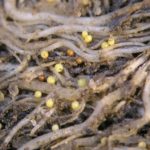Reading Time: 2 minutes Potato producers may soon have a new ally in their battle against late blight, and it’s right under their feet. Researchers have discovered bacterial strains in the soil that show promise as disease controls. Some bacteria suppress or inhibit late blight by over 90 per cent, according to an Agriculture and Agri-Food Canada (AAFC) release. […] Read more

Soil bacteria may offer weapon against late blight in potatoes

Potato ‘fields’ clarified for cross-border trade
Reading Time: 2 minutes Canadian and U.S. food inspectors have agreed on what they mean by a “field” in any restrictions they place on potato trade on account of potato cyst nematodes. The Canadian Food Inspection Agency (CFIA) and U.S. Department of Agriculture’s Animal and Plant Health Inspection Service (APHIS) on Tuesday announced new revisions to their Guidelines on Surveillance and Phytosanitary […] Read more

USDA clears GMO potato with lower cancer risk
Reading Time: 2 minutes CORRECTED, Nov. 10, 2014 — Washington | Reuters — The U.S. Department of Agriculture on Friday approved the first genetically modified potato for commercial planting in the United States in more than a decade, a move likely to draw the ire of groups opposed to artificial manipulation of foods. The so-called Innate potato, developed by the […] Read more

Wild varieties
A set of wild South American potato varieties with Colorado potato beetle resistance have donated genetic material to their North American cousins
Reading Time: 4 minutes When European explorers to South America first brought potatoes back to their home countries, it was a select few varieties they chose: those that could grow under longer day lengths. Most of the varieties at the Equator tuberize under short day lengths and can’t grow in the global North. As a result, the potatoes we […] Read more

Abundant choices
There’s no shortage of crop protection choices for just about any problem a grower might face in the 2014 season, including a number of new options registered in time for this spring
Reading Time: 4 minutes We are a fortunate lot, here in Canada, when it comes to controlling pests in our crops. We have access to literally hundreds of products which can be used alone or in tank mixes to control just about any weed, insect, or disease we might encounter in any crop we are likely to grow. In […] Read more

Hard wired
Several factors are encouraging the return of an old pest enemy — the wireworm group — that had long been a thing of the past for Canadian farmers
Reading Time: 5 minutes They live quietly in your fields for as long as two or three seasons, silently but slowly damaging your crops and undermining your farm’s profitability. Their top hosts are grassy crops such as corn, but they’ve even been known to feed on potatoes, scarring the tubers with long feeding holes. Wireworms damage grassy plants in […] Read more

“Let’s make some food”
Canada has enormous potential to increase irrigation in Saskatchewan. So why is so little happening?
Reading Time: 7 minutes Using only 20 per cent of the available supply, there is enough water running through Saskatchewan’s Gardiner Dam at Lake Diefenbaker to irrigate half a million acres. The potential for farm diversification and value-added processing would add billions to the national agriculture economy and cement Canada’s role in feeding a hungry world. And the other […] Read more


